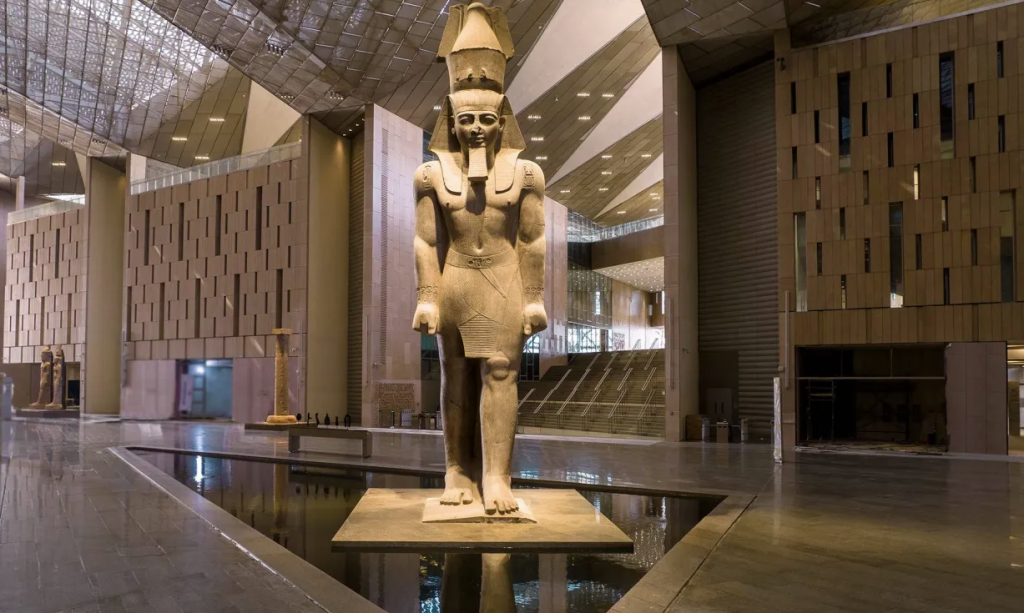A 3,200-year-old towering statue of the warrior king, Ramses II, standing 36ft high and weighing in at 183,000lbs, stands in the entrance way of the new Grand Egyptian Museum, GEM. Beyond it, the Grand Staircase, lined with the statues of other ancient Egyptian kings and queens, leads you upstairs to perfectly framed views of the Giza Pyramids.
Costing some $1.2bn and more than 20 years in the making, GEM was initially scheduled to open in 2012, but the launch was repeatedly delayed by financial crises, by the 2011 Arab Spring, by the Covid-19 pandemic, and by regional tensions and wars. Finally, the official opening has come.
The museum is colossal. It’s the largest archaeological museum in the world. Designed by Dublin-based firm Heneghan Peng Architects, the building’s layout aligns precisely with the Great Pyramid of Khufu and the Pyramid of Menkaure. The exterior, with its pyramid-shaped entrance, is covered in hieroglyphs and triangular pieces of translucent alabaster, and spans 5.4 million square feet (about the size of 70 football pitches).
Described as the world’s largest archaeological museum, GEM is packed with more than 100,000 artefacts, in 12 exhibition galleries, spanning more than 5,000 years of Egyptian antiquity, from pre-dynastic times to the Greco-Roman era. Some of the items on display here have never before been seen by the public, while others, including around 4,500 funerary objects, were previously scattered around the country, including in the Egyptian Museum in downtown Cairo.
My introduction to GEM was under the tutelage of Egyptologist Eman Shawky Mahmoud. Egypt travel expert Sheri Fazleabas, owner of A&S Signature Journeys, had connected me with Eman, and I couldn’t think of a better person to have visited the museum with.
After graduating from the University of Cairo with her Master’s degree, Eman worked on translating hieroglyphic texts, before becoming a guide, something she has now been doing for more than 20 years. Currently pursuing her PhD in archaeology, in the niche area of the use of false hair in ancient Egypt (including wigs and false beards), she was the perfect person to tour the museum with. Passionate about everything to do with Ancient Egypt, Eman guided us through the vast complex, steering us towards some of her favorite pieces and explaining everything in such a way that it made the sheer quantity on display seem approachable.
Personal highlights included the Queen Hetepheres collection. Found in a hidden burial chamber near the Great Pyramid of her son King Khufu, the collection includes her bed, chair, sarcophagus, canopic jars, and a box of bracelets. Another favorite was the oversized statue of Queen Hatshepsut offering pots to the god Amun-Re. Hatshepsut became regent for her nephew King Thutmose III, and was later crowned as joint ruler. This statue of her is one of the most beautiful in the collection.
The 4,500-year-old, limestone statue of scribe Nefer, with his dramatic kohl-lined eyes, was another standout. The statue portrays him in the classic scribe pose with his legs crossed and a papyrus scroll resting on his lap. While in the fourth gallery, centered around “beliefs”, an impressive statue of Osiris, the god of death and rebirth, illustrates the ancient Egyptian beliefs around death and rebirth.
When asked her museum favorites, Eman says, “from the tiniest scarab to the grandest statue, every single piece makes a difference. I’m especially fascinated by the jewelry; it’s incredible how advanced and artistic they were thousands of years ago. It really feels like we’re just completing what they started. I also have a soft spot for the pottery, it’s so beautiful and timeless.”
While most of the museum’s galleries have been open to the public since November last year, with the official opening comes access to new displays including the entire contents of Tutankhamun’s tomb, displayed together for the first time since being found by British Egyptologist Howard Carter in 1922. Two entire galleries, the work of Stuttgart-based Atelier Brückner (who also designed the museum’s Grand Staircase and atrium), include such items as Tutankhamun’s spectacular gold mask, throne, chariots and jewelry.
“I had to think, how can we show him in a different way,” says Dr Tarek Tawfik, president of the International Association of Egyptologists, associate professor of Egyptology at Cairo University and former director general GEM, “because since the discovery of the tomb… already about 1,800 pieces, from a total of over 5,500 that were inside the tomb, have been on display.” Dr Tawfik goes on to say, “I had the idea of displaying the complete tomb, which means nothing remains in storage, nothing remains in other museums, and you get to have the complete experience, the way Howard Carter had it over a hundred years ago.”
Aside from the Tutankhamun exhibit, also on display are the 4,500-year-old funerary boat of Khufu. Believed to have been built to carry the king’s soul to heaven, the first of Khufu’s Solar Boats was discovered in 1954, in a sealed pit at the southern base of the Great Pyramid of Giza. The second was found in a nearby pit. The first boat was originally displayed in a purpose-built museum, the Giza Solar Boat Museum, next to the Great Pyramid, but the decision was made to transfer it to the new GEM. Both boats are now in a special hall within the museum complex, displayed side by side for the first time ever.
Standing in the shadow of the Pyramids, the Grand Egyptian Museum feels both ancient and new. Here, 5,000 years of history have been gathered under one roof, not as simply as relics of the past, but as living symbols of a civilization that’s still shaping the future. Egypt’s newest treasure may house its oldest stories, but its message is entirely modern.

